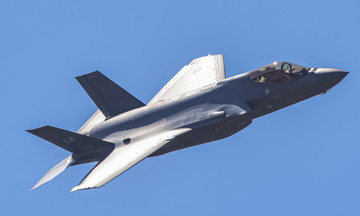The unmanned aerial vehicle (drone), named Kaczka, was unveiled at the 2025 International Defense Industry Exhibition held from 2/9 to 5/9 in Kielce, Poland.
Developed by the Polish Military Academy, the drone is essentially a large box containing electronic components, topped with a white swan decoy. A camera is concealed within the swan's head.
 |
The Kaczka drone on display at the exhibition on 1/9. Photo: Portal Militarny |
The Kaczka drone on display at the exhibition on 1/9. Photo: Portal Militarny
The Kaczka can be manually controlled within a 5 km radius or operated autonomously. With a 10 kg payload capacity, it's capable of both covert reconnaissance and targeted attacks. The drone can float on water and navigate land with its wheels, although its small wheels may limit its maneuverability on rough terrain.
Ukrainian military news site Defense Express suggests the swan camouflage might deceive observers from a distance, but its effectiveness at close range is questionable. The disguise also likely increases production costs compared to conventional first-person view (FPV) drones, which offer greater range and simpler manufacturing.
This isn't the first animal-inspired drone. In early 2024, Northwest Polytechnic University in China introduced a bird-like drone capable of flapping its wings, with potential military applications.
 |
The Kaczka drone operating on water in a photo released on 3/9. Photo: AWL |
The Kaczka drone operating on water in a photo released on 3/9. Photo: AWL
The EU-funded GRIFFIN project also showcased a robotic bird in 2023 that could perch on branches using claws. The manufacturer described it as a "potential alternative to helicopters."
In 2020, Science Robotics published research by a multinational engineering team on an X-winged bird-like drone weighing just 26 g, suitable for "micro-aerial vehicle" missions.
Pham Giang (Defense Express)












